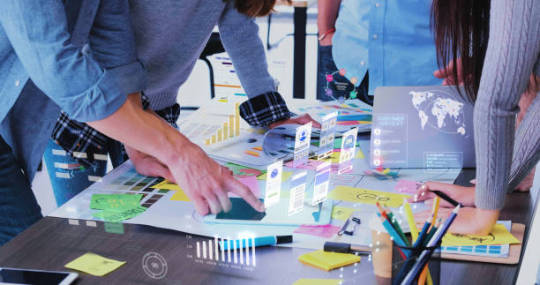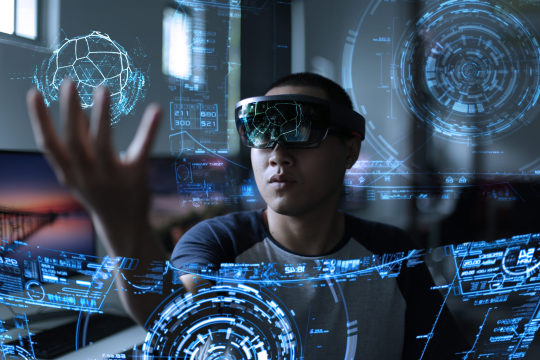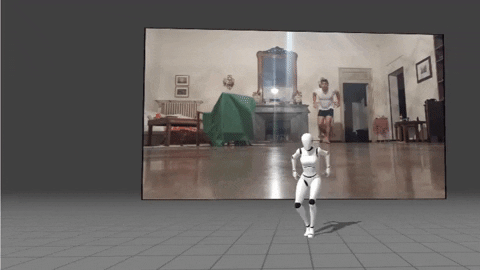#ar/vr development
Explore tagged Tumblr posts
Text
The top 10 AR/VR software development firms that are leading the way in using immersive technology to change industries. These businesses focus on developing cutting-edge virtual reality (VR) and augmented reality (AR) solutions for industries like gaming, healthcare, education, real estate, and more. These companies are transforming user experiences by utilizing AR and VR, from interactive learning and entertainment to training simulations and virtual tours. This list highlights the most significant players influencing the AR/VR market today, whether you're searching for creative solutions for your company or are just interested in the direction of immersive technology.
0 notes
Text

As a leading virtual reality app development firm, we specialize in guiding startups and enterprises across diverse industries to harness the power of AR/VR for digital transformation, enhancing business outcomes and boosting ROI.
#AR/VR Development#appdesign#webdesign#appdevelopment#websitedevelopment#webdevelopment#androiddevelopment#androidstudio#iosdevelopment#developer#app development
0 notes
Text
The Impact of User Experience on the Success of AR/VR Apps

Augmented reality (AR) and virtual reality (VR) are transforming the way we interact with digital content. These immersive technologies are not just about cutting-edge graphics or innovative concepts; they hinge on offering an outstanding user experience (UX). In the highly competitive landscape of AR/VR app development services, UX is a critical choice for success.
What is the user experience in AR/VR?
The user experience in AR/VR offers the overall interaction users have with the app, including how intuitive and engaging the app is, the quality of the visuals, and the responsiveness of the system. It also involves the emotional impact on users and how satisfied they feel after using the app.
Key Elements of a Successful AR/VR App UX
1. Ease of Use and Intuitiveness
Simplicity in Navigation: AR/VR applications need to be simple to use. In order to keep down the learning line, users should be able to interact with the app simply.
Natural Interactions: Utilizing natural requests and interactions, such as eye tracking and hand movements, can enhance usability and immersion.
2. Immersive Content and Realism
High-Quality Graphics: Realistic images are essential for creating an immersive experience.
Engaging Content: The content must be engaging and relevant to keep users interested. This includes dynamic elements that respond to user actions and a compelling storyline.
3. Performance and Responsiveness
Low Latency: Being late should be minimal to prevent motion sickness and ensure smooth interactions.
Optimal Performance: The app should run smoothly on various devices, ensuring that it is accessible to a broader audience without performance issues.
4. User Feedback and Iteration
Continuous Feedback Loop: Incorporate user feedback to understand pain points and areas for improvement. This progressive process helps refine the app to better meet user needs.
A/B Testing: Use A/B testing to evaluate different design elements and features, allowing for data-driven decisions.
5. Accessibility and Inclusivity
Inclusive Design: Ensure the app is accessible to people with different abilities. This includes users with limited mobility and more.
Customizable Settings: Allow users to customize their experience, such as by adjusting the field of view, volume, and other settings to suit their preferences.
The Impact of Poor UX on AR/VR Apps:
User Frustration and Abandonment
Complex Navigation: If users find it difficult to navigate, they are likely to abandon the app. Poorly designed interfaces can frustrate users and lead to negative reviews.
Motion Sickness: High latency and low frame rates can cause motion sickness, leading to a negative experience and potential abandonment of the app.
Negative Reviews and Poor Ratings
Public Perception: Negative experiences often lead to poor reviews and ratings on app stores, affecting the app’s reputation and deterring potential users.
Reduced Engagement: Users are less likely to return to an app that doesn’t meet their expectations or causes discomfort.
Best Practices for Enhancing UX in AR/VR Apps
1. User Testing and Feedback
Conduct extensive user testing to identify and fix usability issues.
Regularly collect and analyze user feedback to continuously improve the app.
2. Focus on Performance Optimization
Optimize the app for various devices to ensure smooth performance and accessibility.
Minimize latency and improve frame rates to enhance the overall user experience.
3. Prioritize Content Quality
Invest in high-quality content that is relevant and engaging.
Regularly update content to keep users interested and returning to the app.
4. Ensure Inclusivity
Design the app to be accessible to users with diverse needs and preferences.
Incorporate features that allow users to customize their experience.
Conclusion
At xceltec AR and VR, delivering an exceptional user experience is not just a bonus but a necessity. As technology continues to evolve, so too must the focus on creating intuitive, engaging, and high-performance applications. By prioritizing UX, developers can ensure the success and longevity of their AR/VR development in an increasingly competitive market.
0 notes
Text
The Advancement of AR/VR Development: Molding the Eventual fate of Vivid Encounters

In the domain of innovation, scarcely any developments have caught the creative mind very like Expanded Reality (AR) and Augmented Reality (VR). These extraordinary advancements have opened up new elements of human association, diversion, schooling, and business. From upgrading our existence with advanced overlays to submerging us in altogether virtual universes, AR and VR development keep on pushing the boundaries of what's conceivable. How about we dig into the advancement of AR/VR development and investigate how it's forming the eventual fate of vivid encounters.
The Beginnings:
The foundations of AR and VR development can be followed back a very long while. Early analyses laid the basis for what might ultimately become current AR and VR advances. In the late twentieth hundred years, researchers and trend-setters started investigating ways of making vivid advanced encounters. Notwithstanding, it was only after the early 2010s that AR and VR started acquiring standard consideration with the approach of gadgets like the Oculus Break and Google Glass.
Early Difficulties:
The early long stretches of AR/VR development were characterized by various specialized and viable difficulties. Establishing persuading virtual conditions required conquering issues connected with hardware constraints, movement affliction, and dormancy. Engineers needed to track down imaginative answers for advance execution and upgrade client experience.
Forward leaps and Developments:
Regardless of the difficulties, leap forwards in hardware and software made ready for huge progressions in AR/VR development. The presentation of additional strong designs handling units (GPUs), movement following sensors, and high-goal shows empowered engineers to make more vivid and reasonable encounters. Moreover, headways in PC vision, AI, and spatial registering advances improved the abilities of AR and VR applications.
Applications Across Enterprises:
AR and VR development have tracked down applications across a large number of enterprises, changing how we work, learn, and play. In the domain of schooling, these advancements offer vivid learning encounters that draw in understudies and work with more profound comprehension of complicated subjects. In healthcare, AR/VR arrangements are being utilized for clinical preparation, careful recreations, and treatment. Media outlets has embraced AR and VR for gaming, narrating, and vivid encounters, for example, virtual shows and amusement park attractions. In addition, AR/VR innovation is upsetting retail by empowering virtual take a stab at encounters and vivid item shows.
The Ascent of Blended Reality (MR):
As AR and VR advancements keep on developing, we're seeing the rise of Blended Reality (MR), which mixes components of both genuine and virtual universes. MR encounters consistently coordinate computerized satisfied with the actual climate, offering clients a more vivid and intelligent experience. Microsoft's HoloLens and Sorcery Jump's Enchanted Jump One are instances of MR gadgets that are pushing the boundaries of spatial processing and intelligent holographic presentations.
Future Viewpoint:
The eventual fate of AR/VR development is overflowing with potential outcomes. As hardware turns out to be all the more impressive and reasonable, we can hope to see significantly more prominent reception of vivid advances across various areas. Further developed calculations and computer based intelligence driven progressions will upgrade the authenticity and intuitiveness of AR and VR encounters. Moreover, the combination of AR/VR with other arising advancements, for example, 5G, edge registering, and the Web of Things (IoT) will open new open doors for development and cooperation.
End:
AR and VR development have made some amazing progress since their commencement, and they keep on reclassifying how we see and connect with the computerized world. With each mechanical jump forward, we inch more like a future where vivid encounters are flawlessly incorporated into our regular routines. As designers and pioneers keep on pushing the boundaries of what's conceivable, one thing is sure: the excursion towards really vivid and intuitive encounters is far from over. AR and VR are not simply innovations; they are windows into a future where the line between the genuine and the virtual hazy spots, opening up vast opportunities for investigation and revelation.
0 notes
Text
#technology#appdevelopment#development#developers#application#software#mobileappdevelopment#mobileappdevelopers#mobile app developer company#mobile app developers#mobileappdesign#b2b#AI#ai software development company#AR/VR development
0 notes
Text
Elevate Your Website’s Security with WordPress Security Services
Your WordPress website is a valuable asset that deserves top-tier protection. At Atcuality, we provide comprehensive WordPress security services to safeguard your site from cyberattacks and data breaches. Our team starts with an in-depth analysis of your website’s security framework, identifying and addressing vulnerabilities. We implement state-of-the-art measures such as malware scanning, brute force protection, and database encryption to enhance your site’s security posture. Additionally, we offer ongoing maintenance and support to ensure your site remains secure over time. With Atcuality, your website is not only protected but optimized for performance. Trust us to keep your digital assets safe and help you maintain a competitive edge in the online world.
#wordpress#website#web development#web design#web developing company#website development#web developers#ai generated#artificial intelligence#ai applications#iot#iot applications#iot development services#iotsolutions#iot platform#digitaltransformation#technologynews#techinnovation#augmented reality#augmented human c4 621#augmented and virtual reality market#augmented intelligence#metaverse#virtual reality#ar vr technology#amazon services#cloud server hosting#ssl#sslcertificate#ssl certificates
2 notes
·
View notes
Text
APPLE’S REJECTION OF META AI TOOLS: A STANCE ON PRIVACY AND SECURITY
#Technology#AI#Artificial Intelligence#Generative AI#Omniverse#NVIDIA#VR#AR#Programing#Python#HTML#JavaScript#Full Stat Developers#programmers#Artist#Developers#Graphic Designers#IndieGames#Indie Games#Hard Surface Developer#Security#Hackers#DoS#Denial of Service#Phishing#Social Media#Internet Protocol#Sockets#Scams#ID Theft
6 notes
·
View notes
Text
Gaming Technology Trends to Watch in 2024

Gaming in 2024 is set to revolutionize the industry with groundbreaking advancements in technology. Virtual Reality (VR) and Augmented Reality (AR) are creating more immersive experiences, while blockchain and NFTs are reshaping game economies. The rise of 5G enhances connectivity, enabling seamless cloud gaming and multiplayer experiences. Accessibility and inclusivity are becoming focal points, ensuring games cater to diverse audiences. The metaverse and social gaming are transforming platforms into interactive social hubs, and cloud gaming continues to expand with lower latency and broader libraries. At Devstree Studio, we’re at the forefront, crafting innovative games that redefine possibilities in this ever-evolving landscape.
#game development#html5 game#metaverse#metaverse game development#nft game development#game developers#video games#ar vr technology#augmented reality#vr games#unity game development#unity3d#unity 3d game development
2 notes
·
View notes
Text
2 notes
·
View notes
Text

As a leading virtual reality app development firm, we specialize in guiding startups and enterprises across diverse industries to harness the power of AR/VR for digital transformation, enhancing business outcomes and boosting ROI.
#AR/VR Development#app development#developer#mobile app development#website development#websitedevelopment#webdesign#app developers#android app development#software
0 notes
Text

AR or Augmented Reality and VR or Virtual Reality are the technical inventions that help live our imaginations before our eyes through simulations. AR/VR can be programmed with IoT objects to offer optimal audio-visual experiences that can rival or replicate a physical world without the help of any tangible media.
But, how to program these elements?
The popular programming languages help you build the simulations that bring AR/VR tech to life for the audience. Languages like C#, Python, JavaScript, JAVA, Swift, C++, Rust, and APIs like WebGL allow developers to build the right AR/VR for the users.
Are you willing to build AR/VR tech for your business? Hire Augmented Reality Developers or Virtual Reality Developers via Remote72.
#ar vr technology#augmented reality#virtual reality#app development#developer#programming#software engineering#software#ar vr development services#python#java#javascript#webgl#developers#iot#iot tech#internetofthings#technology#tech
2 notes
·
View notes
Text
#theintellify#mobile application development#web application development#cloud consulting services#augmented reality#virtual reality#ar vr technology#arvr#ar vr development company#ar vr development services
2 notes
·
View notes
Text

AR/VR app development services bring immersive experiences to life. Elevate user engagement through innovative, interactive solutions tailored to your needs.
For more information: https://www.xceltec.com/
0 notes
Text

#IFTTT#Giphy#giphyupload#3d#vr#ar#development#unreal#virtualreality#unreal engine#xr#motion capture#ue5#animaiton
2 notes
·
View notes
Text
youtube
React to light, and cast shadows.
#apple vision pro#vision pro#visionpro#apple#minority report#black mirror#philip k dick#ar vr development company#arvr#augmented reality#virtual reality#machine learning#Youtube
6 notes
·
View notes